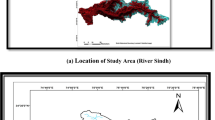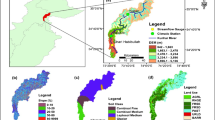Abstract
According to the impact of climate change on the thermal stratification which results in a quality change of dams outflow, this study aims to present a framework to assess the impacts of climate change on altering thermal regimes of dam reservoirs. Therefore, five Atmosphere–Ocean Global Circulation Models (AOGCM-AR5 models) under two emission scenarios (RCP2.6 and RCP8.5) are used to investigate the change of air temperature, precipitation, wind speed, relative humidity, dam inflow and water temperature in 2020–2039. To quantify these impacts, three models are used, namely rainfall–runoff IHACRES, hydrodynamic model CE-QUAL-W2 and a downscaling model of LARS-WG. The efficiency of the proposed framework was evaluated in Latian Dam in Iran. Results show an increment of long-term air temperature average by 0.7 °C and, consequently, water surface temperature by 0.59 °C in 2020–2039 relative to the baseline period (1990–2009). Precipitation, wind speed and relative humidity decrease due to climate change in the future by 57%, 17% and 11%, respectively. The simulated dam inflows show that the maximum of 89% of the dam inflow decreases in the future period relative to the baseline period. The results indicate that the water temperature will increase in the coming period as the air temperature increases and this will lead to the extension of thermal stratification period up to 52 days.










Similar content being viewed by others
References
Arhonditsis GB, Brett MT, DeGasperi CL, Schindler DE (2004) Effects of climatic variability on the thermal properties of Lake Washington. Limnol Oceanogr 49(1):256–270
Ashofteh P, Bozorg Haddad O, Miguel Mariño MA (2012) Climate change impact on reservoir performance indexes in agricultural water supply. J Irrig Drain Eng 139(2):85–97
Azadi F, Ashofteh PS, Loáiciga HA (2019) Reservoir water-quality projections under climate-change conditions. Water Resour Manag 33(1):401–421
Blenckner T, Omstedt A, Rummukainen M (2002) A Swedish case study of contemporary and possible future consequences of climate change on lake function. Aquat Sci 64(2):1–14
Coats R, Perez-Losada J, Schladow G, Richards R, Goldman C (2006) The warming of lake Tahoe. Climatic Chang 76(1–2):121–148
Cole TM, Buchak EM (1995) CEQUALW2: a two-dimensional, laterally averaged, hydrodynamic and water quality model, version 3.2. US Army Crops of Engineers, Vickburg
Cole TM, Wells SA (2006) CE-QUAL-W2: a two-dimensional, laterally averaged, hydrodynamic and water quality model, version 3.5
Croke B, Andrews F, Spate J, Cuddy S (2004) IHACRES user guide. [online]. http://icam.anu.edu.au/IHACRESv2.0UserGuide.pdf
Engelund F (1978) Effect of lateral wind on uniform channel flow. Progress Report 45, Institute of Hydrodynamics and Hydraulic Engineering, Technical University of Denmark
Fagre DB, Comanor PL, White JD, Hauer FR, Running SW (1997) Watershed responses to climate change at glacier national park. J Am Water Resour Assoc 33(4):755–765
Fang X, Stefan HG, Alam SA (1999) Simulation and validation of fish thermal DO habitat in North-Central U.S. lakes under different climate scenarios. Ecol Model 118(2–3):167–191
Goodarzi E, MassahBavani A, Dastorani M, Talebi A (2014) Evaluating effect of downscaling methods; change-factor and LARS-WG on surface runoff (a case study of Azam-Harat River basin, Iran). Desert 19(2):99–109
Hampton SE, Izmest’eva LR, Moore MV, Katz SL, Dennis B, Silow EA (2008) Sixty years of environmental change in the world’s largest freshwater lake-Lake Baikal, Siberia. Glob Change Biol 14(8):1947–1958
Hordoir R, Meier HEM (2012) Effect of climate change on the thermal stratification of the Baltic Sea: a sensitivity experiment. Clim Dyn 38(9–10):1703–1713
IPCC (1996) In: Moss RH, Watson TT, Zinyowera MC (eds) Climate change 1995: the IPCC Second Assessment Report impacts, adaptations, and mitigation of climate change: scientific-technical analysis. Cambridge University Press, UK, p 879
IPCC (2013) Climate change 2013, the physical science basis. Contribution of working group I to the fifth assessment report of the intergovernmental panel
Jakeman AJ, Hornberger GM (1993) How much complexity is warranted in a rainfall–runoff model? Water Resour Res 29(8):2637–2649
Jeppesen E, Kronvang B, Meerhoff M, Søndergaard M, Hansen KM, Andersen HE, Lauridsen TL, Liboriussen L, Beklioglu M, Ozen A, Olesen JE (2009) Climate change effects on runoff, catchment phosphorus loading and lake ecological state, and potential adaptations. J Environ Qual 38(5):1930–1941
Jewell PW (1992) Hydrodynamics controls of anoxia in shallow lakes. In: Whelan JK, Farrington JW (eds) Organic matter: productivity, accumulation, and presentation in recent and ancient sediments. Columbia University Press, New York, pp 201–228
Jones R (2001) Assessing the risk of climate change on the water resources of the Macquarie River Catchment. Integrating Models for Natural Resources Management across Disciplines, issues and scales (Part 2), Modsim 2001 International Congress on Modelling and Simulation, Modelling and Simulation Society of Australia and New Zealand
Jones PD, Hulme M (1996) Calculating regional climatic time series for temperature and precipitation: methods and illustrations. Int J Climatol 16(4):361–377
Kaushal S, Likens G, Jaworski N, Pace M, Sides A, Seekell D, Wingate R (2010) Rising stream and river temperatures in the United States. Front Ecol Environ 8(9):461–466
Khan MS, Coulibaly P, Dibike Y (2006) Uncertainty analysis of statistical downscaling methods. J Hydrol 319(1):357–382
Knutson TR, Zhang R, Horowitz LW (2016) Prospects for a prolonged slowdown in global warming in the early 21st century. Nat Commun 7:13676
Komatsu E, Fukushima T, Harasawa H (2007) A modeling approach to forecast the effect of long-term climate change on lake water quality. Ecol Model 209(2):351–366
Lam DCL, Schertzer WM, Fraser AS (1987) Oxygen depletion in Lake Erie: modelling the physical, chemical and biological interaction, 1972 and 1979. J Great Lakes Res 13(4):782–800
Lee H, Kim E, Park S, Choi J (2012) Effects of climate change on the thermal structure of lakes in the Asian Monsoon Area. Clim Change 112(3–4):859–880
Li Y, Huang TL, Zhou ZZ, Long SH, Zhang HH (2017) Effects of reservoir operation and climate change on thermal stratification of a canyon-shaped reservoir, in northwest China. Water Sci Technol Water Supply. https://doi.org/10.2166/ws.2017.068
Livingstone DM (2003) Impact of secular climate change on the thermal structure of a large temperature central European lake. Clim Chang 57(1–2):205–225
McCormick MJ (1990) Potential changes in thermal structure and cycle of Lake Michigan due to global warming. Trans Am Fish Soc 119(2):254–264
Mikhail AS, Barrow EM (1997) Use of a stochastic weather generator in the development of climate change scenarios. Clim Change 35(4):397–414
Mikhail AS, Stratonovitch P (2010) Use of multi-model ensembles from global climate models for assessment of climate change impacts. Clim Res 41(1):1–14
Modiri-Gharehveran M, Etemad-Shahidi A, Jabbari E (2014) Effects of climate change on the thermal regime of a reservoir. Proc Inst Civ Eng Water Manag 167(10):601–611
Molina-Navarro E, Trolle D, Martínez-Pérez S, Sastre-Merlín A, Erik Jeppesen (2014) Hydrological and water quality impact assessment of a Mediterranean limno-reservoir under climate change and land use management scenarios. J Hydrol 509:354–366
Mooij WM, Hulsmann S, Domis LND, Nolet BA, Bodelier PLE, Boers PCM, Pires LMD, Gons HJ, Ibelings BW, Noordhuis R, Portielje R, Wolfstein K, Lammens EHRR (2005) The impact of climate change on lakes in the Netherlands: a review. Aquat Ecol 39(4):381–400
Norton WR, Roesner LA, Orlob GT (1968) Mathematical models for predicting thermal change in impoundments, EPA water pollution control research series. U.S. Environmental protection Agency, Washington
O’Reilly CM, Alin SR, Plisnier PD, Cohen AS, McKee BA (2003) Climate change decreases aquatic ecosystem productivity in Lake Tanganyika, Africa. Nature 424:766–768
Oudin LV, Andréassian C, Perrin C, Michel C, Moine NL (2008) Spatial proximity, physical similarity, regression and ungaged catchments: a comparison of regionalization approaches based on 913 French catchments. Water Resour Res. https://doi.org/10.1029/2007WR006240
Pérez-Fuentetaja A, Dillon PJ, Yan ND, McQueen DJ (1999) Significance of dissolved organic carbon in the prediction of thermocline depth in small Canadian Shield lakes. Aquat Ecol 33(2):127–133
Racsko P, Szeidl L, Semenov M (1991) A serial approach to local stochastic weather models. Ecol Model 57(1–2):27–41
Raj A (2016) Climate change: cause, impact and mitigation strategies. S Indian J Biol Sci 2(4):363–367
Reynolds CS (2006) The ecology of phytoplankton. Cambridge University Press, Cambridge
Rodi W (1993) Turbulence models and their application in Hydraulics, 3rd edn. IAHR, A.A. Balkema, Rotterdam
Sabeti R, Jamali S, Jamali HH (2017) Simulation of thermal stratification and salinity using the Ce-Qual-W2 model (case study: mamloo dam). Eng Technol Appl Sci Res 7(3):1664–1669
Sahoo GB, Schladow SG, Reuter JE, Coats R (2011) Effects of climate change on thermal properties of lakes and reservoirs, and possible implications. Stoch Env Res Risk Assess 25(4):445–456
Schertzer WM, Sawchuck AM (1990) Thermal structure of the lower great lakes in warm year: implication for the occurrence of hypolimnion anoxia. Trans Am Fish Soc 119(2):195–209
Simoes F (1998) An eddy viscosity model for shallow-water flows. Water resources engineering 98. ASCE, NY, pp 1858–1863
Straile D, Livingstone DM, Weyhenmeyer GA, George DG (2003) The response of freshwater ecosystems to climate variability associated with the North Atlantic Oscillation
Trzaska S, Schnarr E (2014) A review of downscaling methods for climate change projections. United States Agency for International Development by Tetra Tech ARD, pp 1–42
Vaze J, Post DA, Chiew FHS, Perraud JM, Viney NR, Teng J (2010) Climate non-stationarity–validity of calibrated rainfall–runoff models for use in climate change studies. J Hydrol 394(3):447–457
Whitehead P, Wilby R, Battarbee R, Kernan M, Wade AJ (2009) A review of the potential impacts of climate change on surface water quality. Hydrol Sci J 54(1):101–123
Wilby RL, Harris I (2006) A framework for assessing uncertainties in climate change impacts: low-flow scenarios for the River Thames, UK. Water Resour Res. https://doi.org/10.1029/2005WR004065
Wu G, Liu Y, He B, Bao Q, Duan A, Jin FF (2012) Thermal controls on the Asian summer monsoon. Sci Rep 2:404. https://doi.org/10.1038/srep00404
Young P, Beven K (1991) Computation of the instantaneous unit hydrograph and identifiable component flows with application to two small upland catchments. J Hydrol 117(1–4):275–300
Zhang C, Lai S, Gao X, Xu L (2015) Potential impacts of climate change on water quality in a shallow reservoir in China. Environ Sci Pollut Res 22(19):14971–14982
Acknowledgements
The authors wish to thank all who assisted in conducting this work.
Author information
Authors and Affiliations
Corresponding author
Additional information
Editorial responsibility: S.R. Sabbagh-Yazdi.
Rights and permissions
About this article
Cite this article
Firoozi, F., Roozbahani, A. & Massah Bavani, A.R. Developing a framework for assessment of climate change impact on thermal stratification of dam reservoirs. Int. J. Environ. Sci. Technol. 17, 2295–2310 (2020). https://doi.org/10.1007/s13762-019-02544-8
Received:
Revised:
Accepted:
Published:
Issue Date:
DOI: https://doi.org/10.1007/s13762-019-02544-8




